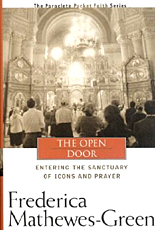"I find it hard to keep talking in the presence of this icon; it communicates something so profoundly beautiful — tranquil, filled with tender life — that it seems all the earth should keep silence. That's quite a change for me, because for a long time I didn't like icons at all. They didn't appeal to me; they didn't even make sense. When other people talked about how beautiful and moving icons were, I'd arrange my features into a thoughtful, serious expression, but inside I'd be thinking, 'I have no idea what they're talking about.'
"Icons seemed to me the opposite of appealing. The art looked like bad art, with clumsy perspective and unrealistic faces. Worst of all, icons didn't convey emotion. Everyone looked so stiff and unfriendly. When it came to religious art, I much preferred to stroll the halls of the National Gallery of Art and view color-saturated canvases from the Renaissance, full of plump babies and yearning eyes cast upwards. Art that showed people who looked like real people, portrayed in ways that tugged the heartstrings.
"That is decidedly what icons do not do. If you're like I was, it takes a while for this icon of Christ to 'speak' to you. When it does, it communicates something subtle, very different from the clear, dramatic message you get from a Renaissance canvas.
"Look at the icon of Christ again. You may find his gaze unsettling, as if He is looking back at you, or even through you. My husband, a pastor, once received a phone call from a retired humanities professor. The caller said that he was a lifelong atheist and humanist who was mostly ignorant of religion. But then someone had given him a copy of this icon. 'When I look at it, I have the sensation that He's looking into my soul,' he said. 'Before this, I didn't even think there was such a think as a soul.' "
